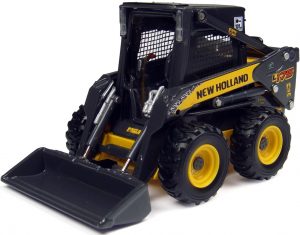Complete workshop & service manual with electrical wiring diagrams for New Holland C175, L175 Skid Steer (Compact Track Loader). It’s the same service manual used by dealers that guaranteed to be fully functional and intact without any missing page.
This New Holland C175, L175 Skid Steer (Compact Track Loader) service & repair manual (including maintenance, overhaul, disassembling & assembling, adjustment, tune-up, operation, inspecting, diagnostic & troubleshooting…) is divided into different sections. Each section covers a specific component or system with detailed illustrations. A table of contents is placed at the beginning of each section. Pages are easily found by category, and each page is expandable for great detail. The printer-ready PDF documents work like a charm on all kinds of devices.
“87630289.pdf”
New Holland C175, L175 Skid Steer (Compact Track Loader) Workshop Manual
Print No. 87630289
967 pages
C175, L175 REPAIR MANUAL TABLE OF CONTENTS
SECTION 00 – GENERAL INFORMATION SECTION 10 – ENGINE
SECTION 27 – TRACKS AND MOTORS SECTION 29 – HYDROSTATIC TRANSMISSION SECTION 33 – BRAKES AND CONTROLS SECTION 35 – HYDRAULIC SYSTEM
SECTION 37 – TOWING HOOKS AND BALLASTING SECTION 39 – FRAMES
SECTION 44 – AXLES AND WHEELS
SECTION 50 – CAB CLIMATE CONTROL
SECTION 55 – ELECTRICAL SYSTEM
SECTION 82 – FRONT LOADER (BOOM AND MOUNTING PLATE) SECTION 88 – ACCESSORIES
SECTION 90 – PLATFORMS, CAB, BODYWORK, AND DECALS
…
EXCERPT:
SECTION 29- HYDROSTATIC TRANSMISSION
RIGHT HAND FORWARD STEER
The hydrostatic pump displacement is infinitely variable between zero and 100%. A given swashplate position can be affected by drive system pressure, control pressure to the pilot hand control valve from the anti-stall cartridge, pilot hand control lever position, pump drive speed, as well as the servo stroking piston centering springs. Flow direction is determined by which pump servo cylinder control port is pressurized. Steering is caused by porting an opposing pressure to the servo piston causing the servo piston to return towards neutral. The slower the travel side causes the machine to steer in that direction.
There are four shuttle check valves installed in the lower section of the travel system. These shuttle check valves interconnect a number of the control spool output ports.
❷ One of the shuttle check valves interconnects the output from control spool number 1 to both the E and F output ports. The backup alarm switch is also actuated when this controller is activated.
❷ Another shuttle check valve interconnects the output from control spool number 2 to both the C and F output ports.
❷ Another shuttle check valve interconnects the output from control spool number 3 to both the C and D output ports.
❷ Another shuttle check valve interconnects the output from control spool number 4 to both the D and E output ports.
Steering to the RH Forward direction is caused by moving the lever toward the forward direction and also the right hand direction.
Actuating the travel control lever toward the forward direction causes controller number 3 to be pressurized in proportion to the distance that the lever is moved.
Actuating the travel control lever toward the right direction causes controller number 4 to be pressurized in proportion to the distance that the lever is moved.
Activating controller number 3 causes the machine to travel in the forward direction by pressurizing both the C and D Shuttle Check Valves.
Pressurized oil from the C Shuttle Check Valve is connected to the RH Forward servo piston through controller port C and pump port X4B.
Pressurized oil from the D Shuttle Check Valve is connected to the LH Forward servo piston through controller port D and pump port X4A.
Actuating the control lever to the right actuates controller number 4 which pressurizes both the D and E Shuttle Check Valves.
Because shuttle check valve D is already pressurized when controller number 3 is actuated, oil pressure from controller number 4 will not pass through it.
Pressurized oil from controller number 4 then is allowed to pass through Shuttle Check Valve E which is then connected to RH Reverse servo piston through controller port E and pump port X3B.
This pressurized oil ported to the RH Reverse servo piston counteracts the pressure ported to the RH Forward servo piston.
With a difference in pressure at both ends of the RH pump servo piston, the RH travel speed slows down causing the unit to steer to the right.
The amount that the unit steers to the right is proportional to the distance that the lever is moved to the right.
…
